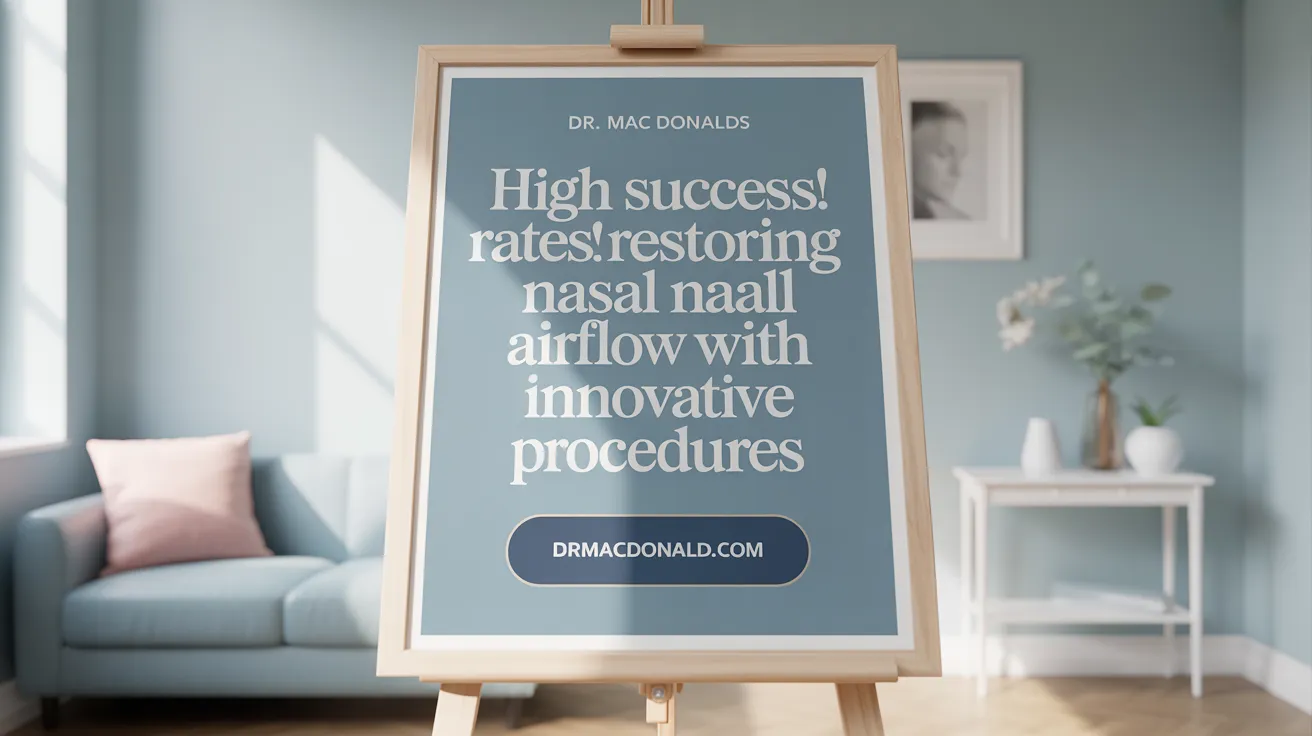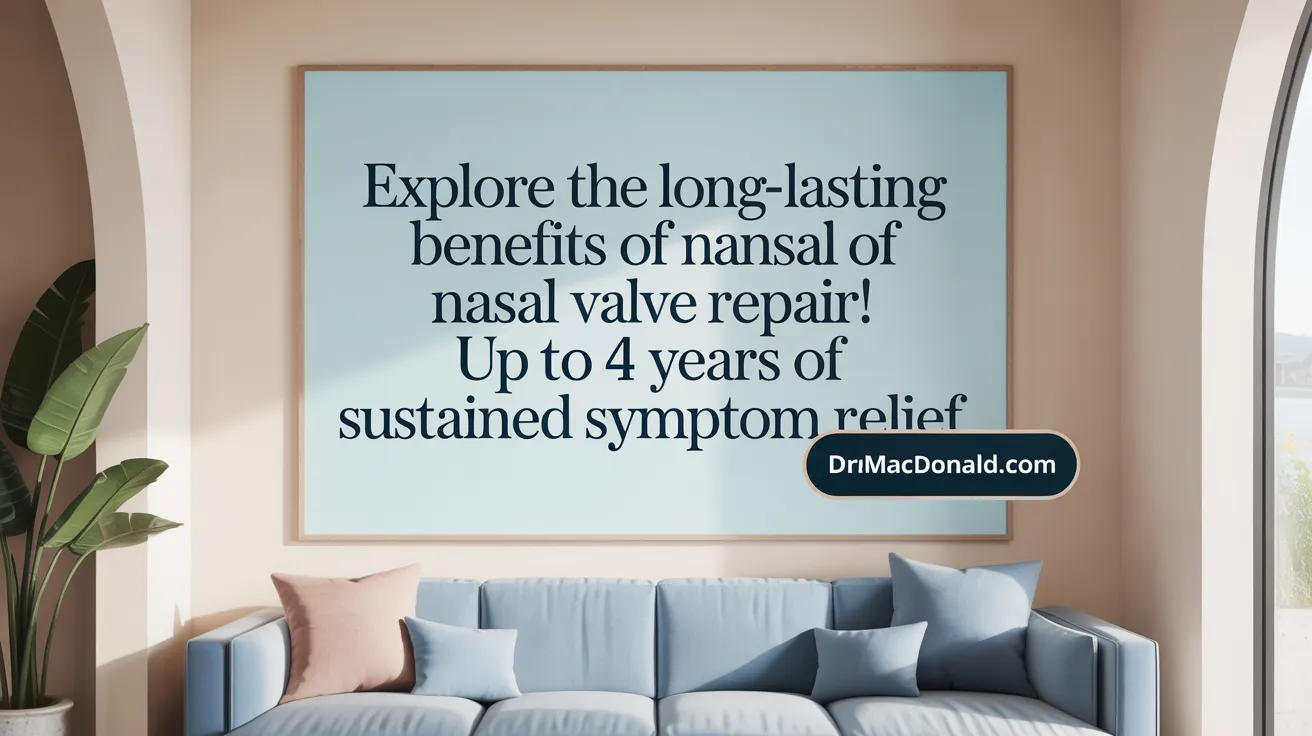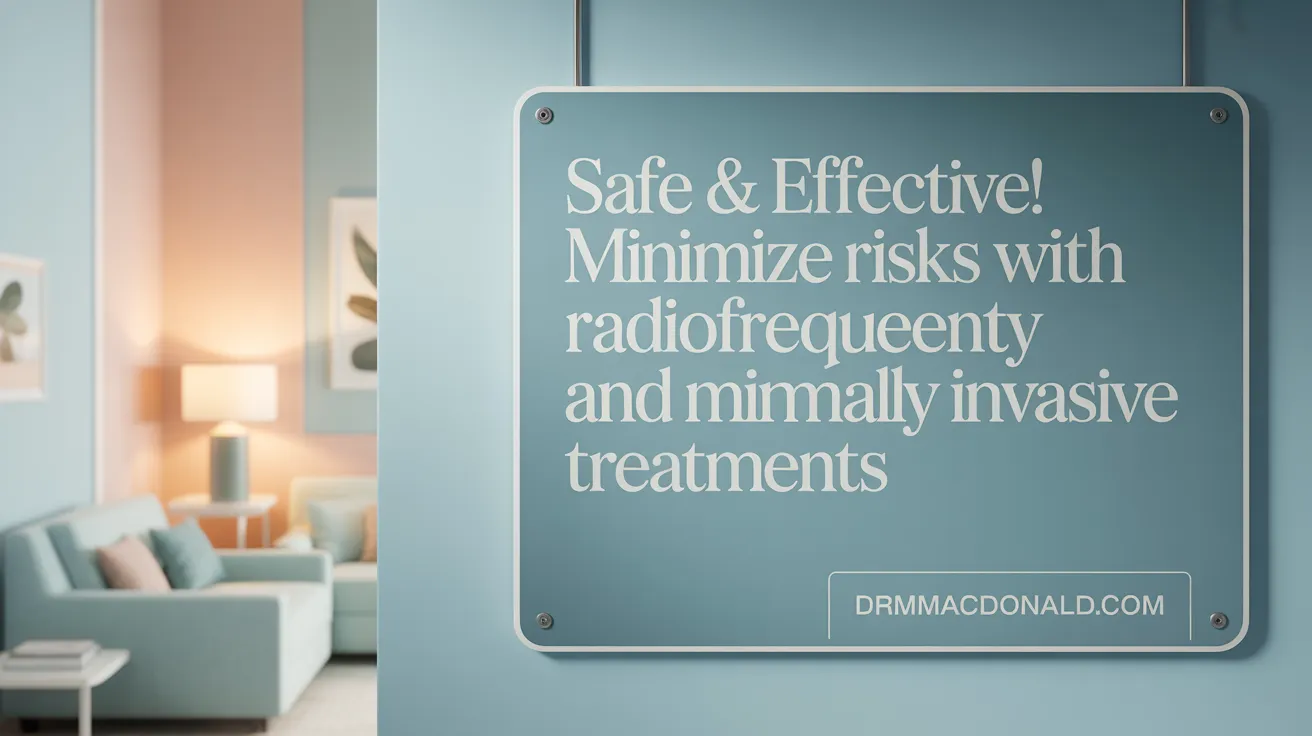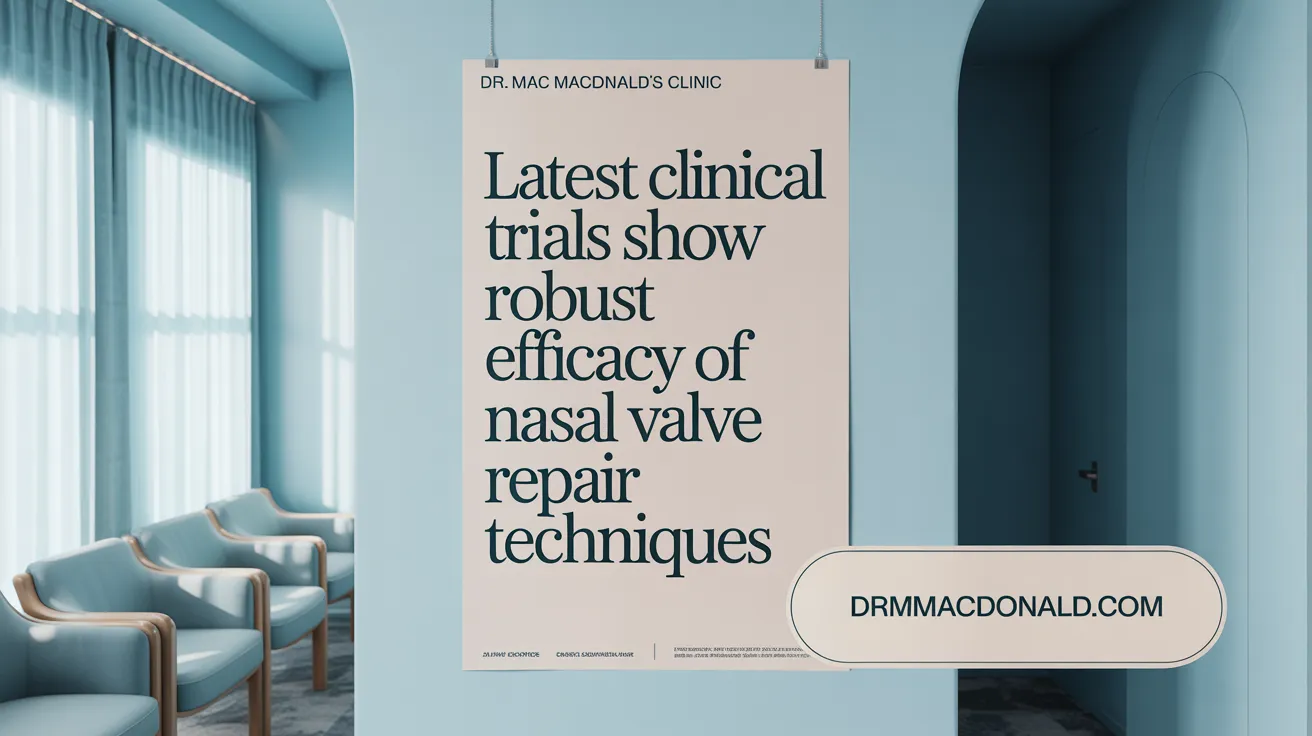Introduction to Nasal Valve Repair and Its Clinical Importance
Nasal valve repair has become a cornerstone in treating nasal airway obstruction caused by the collapse or narrowing of the nasal valve—the narrowest region of the nasal passage significantly impacting airflow. This article delves into the success rates, safety profiles, treatment modalities, and long-term outcomes of nasal valve repair, informed by recent clinical studies and expert insights, to provide a comprehensive overview of how these interventions restore nasal airflow and improve quality of life.
Success Rates of Nasal Valve Repair Procedures in Restoring Nasal Airflow

What is the success rate of nasal valve repair procedures in restoring nasal airflow?
Nasal valve repair procedures are highly regarded for their effectiveness in addressing nasal airflow obstruction, with success rates of nasal valve repair generally reported between 80% and over 90%. Surgical interventions, such as cartilage grafts in nasal surgery, including spreader and alar batten grafts, have shown success rates around 84% to 89%, depending on the specific technique and patient selection. For example, in a comprehensive study involving 53 patients, surgical correction achieved a success rate of approximately 89%, with external valve dysfunction patients experiencing a 100% improvement.
Minimally invasive treatments, including radiofrequency procedures like VivAer, have also demonstrated impressive results. These approaches report success rates around 88% to 92%, with some studies showing symptomatic improvement sustained over long periods, such as two to four years. For example, long-term follow-ups of temperature-controlled radiofrequency (TCRF) treatments indicate responder rates exceeding 93%, with significant and durable improvement in airflow.
Measurement of success typically involves subjective symptom assessments, such as Nasal Obstruction Symptom Evaluation (NOSE) scores, as well as objective tools like acoustic rhinometry and rhinomanometry, which confirm increased nasal patency.
In conclusion, both surgical and minimally invasive nasal valve repairs are effective, with high patient satisfaction and symptom relief. The choice of procedure often depends on individual anatomy, severity of collapse, and overall health, but the overall outlook for treatment success remains very positive.
Long-Term Effectiveness and Durability of Nasal Valve Repair Methods

How effective and durable are nasal valve repair methods in the long term?
Nasal valve repair, especially using minimally invasive techniques like temperature-controlled radiofrequency (TCRF), has shown promising long-term results. Multiple studies with follow-up periods extending up to 48 months confirm that these procedures provide sustained symptom relief.
In particular, TCRF treatment with devices such as VivAer has demonstrated high responder rates, typically between 93% and 96%, indicating that most patients experience significant and lasting improvements. These improvements are measured using the Nasal Obstruction Symptom Evaluation (NOSE) scale, which assesses the severity of nasal airflow obstruction. Patients show a decrease in average NOSE scores from around 81 at baseline to approximately 21.6 after six months, with ongoing maintenance of these improvements over four years.
Compared to traditional surgical repair, which often involves cartilage grafts and structural reconstruction, TCRF and similar office-based procedures offer comparable long-term effectiveness. They are especially beneficial for patients who may be at higher risk from invasive surgery due to age or comorbidities, such as those undergoing nasal implants or radiofrequency remodeling.
Safety data supports a favorable profile for these minimally invasive methods. Over extended follow-up periods, no serious adverse events related to TCRF treatment have been reported. Additionally, these procedures can be performed under local anesthesia, reducing recovery time and associated risks.
In conclusion, modern nasal valve repair methods, notably temperature-controlled radiofrequency therapy, are not only effective in the short term but also provide durable, long-lasting relief that maintains improved nasal airflow and quality of life for several years post-treatment.
Clinical Outcomes and Efficacy of Surgical and Non-Surgical Treatments
Surgical techniques such as septoplasty and cartilage grafting are well-established methods for improving nasal airflow, with success rates often exceeding 80%. Procedures like spreader grafts, alar batten grafts, and open surgical repair effectively widen the nasal passages, reduce nasal obstruction, and enhance quality of life. Clinical studies show that patients undergoing these surgeries experience significant improvements in patient-reported outcomes, such as the SNOT-22 score, which can decrease by approximately 20 points within the first six months and sustain improvements at one-year follow-up.
Minimally invasive treatments, notably temperature-controlled radiofrequency (TCRF) or VivAer, have demonstrated promising long-term results. Studies report that over 90% of patients are responders, with symptom relief maintained for at least 24 to 48 months post-treatment. These techniques remodel nasal tissues through submucosal heating, leading to tissue tightening and stabilization of the nasal valve area, with minimal adverse events reported.
Patient-reported outcomes reveal high satisfaction levels after both surgical and non-surgical interventions. The NOSE scale, a common measure of nasal obstruction severity, shows substantial and lasting reductions in symptoms like congestion and difficulty breathing. Many patients note immediate or near-immediate improvements following procedures.
However, surgical interventions inherently carry some risks, including bleeding, temporary swelling, altered smell, and, rarely, structural complications (postoperative side effects). Non-invasive options such as nasal dilators and external strips provide temporary relief, but they are generally insufficient as standalone long-term solutions for moderate to severe nasal valve dysfunction (limitations of nasal cones and dilator strips).
Expert consensus suggests that selecting the appropriate treatment depends on the severity and dynamic nature of the nasal valve collapse, with a combination of surgical and office-based minimally invasive procedures offering the highest likelihood for durable, symptom-free airflow (evidence-based treatment algorithm for NVO). Advances in imaging and objective measurement tools continue to refine patient selection and improve outcome predictability (objective airflow measurement tools).
Scientific Research and Statistical Data on Nasal Valve Repair Success
 Research on the effectiveness of nasal valve repair and success rates of nasal valve repair varies widely, with most evidence coming from retrospective case series, pilot studies, and clinical reports rather than large-scale randomized controlled trials. These studies typically report success rates ranging from around 65% up to over 90%, depending on multiple factors such as the specific technique used and patient selection criteria.
Research on the effectiveness of nasal valve repair and success rates of nasal valve repair varies widely, with most evidence coming from retrospective case series, pilot studies, and clinical reports rather than large-scale randomized controlled trials. These studies typically report success rates ranging from around 65% up to over 90%, depending on multiple factors such as the specific technique used and patient selection criteria.
For instance, a study involving 53 patients noted a success rate of over 89% in improving nasal airflow following surgical correction, with several patients experiencing significant symptom relief. Similarly, minimally invasive procedures like radiofrequency (RF) treatments, including devices like VivAer, have shown promising results. Some studies highlight responder rates of approximately 88-96%, with notable reduction in nasal obstruction symptoms sustained over several years.
Radiofrequency treatments are often associated with high patient satisfaction and durable improvements, with one long-term study reporting over 97% of patients experiencing sustained relief two years after treatment. Nevertheless, many of these findings stem from small sample sizes or observational studies, underscoring the need for larger, well-designed randomized controlled trials.
Limitations include variability in diagnostic criteria, diverse surgical techniques for nasal valve repair, and differences in patient anatomy, which can influence outcomes. Additionally, some studies mention the need for repeat procedures or adjunct interventions for optimal results. Despite positive reports, the current state of evidence does not allow for conclusive statistical validation across all intervention types.
Overall, while the data suggest that both surgical and minimally invasive options for nasal valve repair are highly effective, definitive success rates backed by rigorous research remain limited. More comprehensive, randomized studies are essential to establish standardized success metrics and confirm long-term efficacy.
Effectiveness and Safety of Temperature-Controlled Radiofrequency and Minimally Invasive Procedures

How effective are specific techniques such as temperature-controlled radiofrequency treatment and minimally invasive procedures for nasal valve repair?
Temperature-controlled radiofrequency (TCRF) treatment is regarded as a highly effective, minimally invasive method for addressing nasal valve collapse, a common cause of nasal airway obstruction. Multiple studies report that around 89.8% of patients experience significant symptom improvement at the 12-month mark, as measured by the Nasal Obstruction Symptom Evaluation (NOSE) scale. Patients typically report a reduction of approximately 45 points in their scores, reflecting substantial relief from symptoms such as nasal congestion, difficulty breathing, and snoring.
The procedure works across various types of nasal valve collapse, including both static and dynamic causes—meaning it is effective whether the collapse occurs at rest or during breathing exertion. Importantly, the treatment is safe, with no serious adverse events reported in controlled studies, showcasing a favorable safety profile.
Another advantage is its suitability for patients who have previously undergone nasal surgeries like rhinoplasty. Such patients respond similarly well to the treatment, indicating its broad applicability. Evidence from post-rhinoplasty nasal obstruction treatment studies supports this.
Patients also appreciate the minimal discomfort and quick recovery associated with TCRF. The procedure is typically performed in-office under local anesthesia, with most experiencing only mild swelling or congestion afterward. Follow-up studies confirm that benefits are sustained over long periods, often extending well beyond a year as documented in long-term outcomes reports.
Given these outcomes, TCRF and similar minimally invasive procedures provide durable, effective solutions for nasal valve problems, especially for those seeking less invasive alternatives to traditional surgery.
Outcomes and Patient Satisfaction Following Nasal Valve Repair
What outcomes are generally observed following nasal valve repair for conditions such as nasal obstruction and collapse?
Following nasal valve repair, significant and sustained improvements in nasal airflow and obstruction symptoms are commonly reported. Patients often see a notable decrease in NOSE (Nasal Obstruction Symptom Evaluation) scale scores, which measure the severity of nasal obstruction. Typically, scores decline from severe or extreme levels at baseline to mild or no symptoms at follow-up periods extending up to 48 months.
Studies involving both surgical and minimally invasive techniques, such as temperature-controlled radiofrequency (TCRF) treatments like VivAer, show that over 80–90% of patients are responders—meaning they experience at least a 15-point improvement in their NOSE scores. These improvements are generally maintained over time, indicating durable symptom relief. Many patients experience a shift from high-severity categories to mild or no problems, leading to better breathing, less congestion, and improved quality of life. The safety profile of these procedures is favorable, with minimal complications reported.
Overall, the outcomes consistently point to long-term alleviation of nasal obstruction symptoms and enhanced nasal airflow, providing substantial relief for patients suffering from nasal valve collapse and other structural issues.
What is the overall success rate and patient satisfaction level with nasal valve repair treatments?
Success rates for nasal valve repair are quite high. Surgical techniques, including spreader grafts, alar batten grafts, and open surgical repair, typically show success rates around 84–89%, with some studies reporting even higher, up to 93%. Patient satisfaction tends to mirror these success rates, as many individuals report substantial improvements in breathing, decreased snoring, and overall quality of life.
Minimally invasive radiofrequency treatments like VivAer and other energy-based procedures also demonstrate excellent efficacy, with responder rates exceeding 92–97% at various follow-ups over 24 months. Patients are generally satisfied with the outcomes, citing rapid improvement, minimal discomfort, and lasting benefits.
In summary, both surgical and office-based therapies for nasal valve dysfunction deliver high success and satisfaction levels, making them promising options for appropriately selected patients. The overall evidence suggests that these procedures offer durable symptom relief, helping patients breathe better and enjoy an improved daily life.
More info:
Patients considering nasal valve repair can expect significant symptom relief and high satisfaction, supported by multiple studies and long-term follow-up data. The choice of technique should be tailored to individual anatomical and functional needs, with both surgical and non-surgical methods demonstrating excellent results. Reliable diagnostic assessments, including clinical examination and objective airflow measurements, help ensure optimal outcomes. For those seeking minimally invasive options, radiofrequency treatments like VivAer are emerging as effective alternatives, especially for patients unfit for surgery or preferring office-based procedures. Overall, the success and happiness of patients post-treatment are strong indicators of the efficacy of nasal valve repair, both surgical and non-surgical.
Key Research Findings and Clinical Trial Results on Nasal Valve Repair Efficacy

What are the key research findings and clinical trial results related to the efficacy of nasal valve repair?
Recent scientific studies and clinical trials provide compelling evidence that nasal valve repair, especially using innovative minimally invasive techniques like temperature-controlled radiofrequency device (RFD) treatments such as VivAer, offer substantial benefits for patients suffering from nasal airway obstruction.
Meta-analyses and systematic reviews frequently report response rates exceeding 80%, with many studies demonstrating that over 90% of patients experience significant symptom relief following treatment. These improvements are quantitatively measured using the Nasal Obstruction Symptom Evaluation (NOSE) scale, which shows considerable reductions, often around 60% to 70%, persisting up to three years post-treatment.
Long-term follow-up studies, including a notable three-year trial, confirm that symptom alleviation and quality of life improvements are maintained over extended periods, with patients reporting better sleep, reduced snoring, and enhanced daytime functioning. Importantly, these minimally invasive procedures are associated with few adverse events, underscoring their safety profile (Safety of TCRF Device Procedure, Treatment Outcomes After Nasal Surgery).
An important aspect of these findings is that prior nasal surgeries, such as rhinoplasty, do not appear to compromise the effectiveness of RFD treatments, which broadens the scope of suitable candidates. Patients previously experiencing nasal valve collapse or obstruction benefit similarly to those undergoing initial repair (post-rhinoplasty nasal obstruction treatment).
Despite the promising data, experts agree that more controlled, randomized clinical trials are necessary to definitively establish the long-term efficacy of these treatments. Current evidence suggests that nasal valve repair using radiofrequency energy remains a highly effective, safe, and patient-friendly option, with results persisting over multiple years and significantly improving respiratory health.
Conclusion: Nasal Valve Repair as a Reliable Solution for Nasal Airflow Restoration
Nasal valve repair, encompassing both surgical reconstruction and minimally invasive radiofrequency treatments, consistently demonstrates high success rates in restoring nasal airflow and alleviating obstruction symptoms. Surgical approaches employing cartilage grafts and structural reinforcement achieve success rates typically between 80% and 90%, with excellent patient satisfaction and durable improvements. Innovative minimally invasive procedures such as temperature-controlled radiofrequency (TCRF) treatments offer effective, safe, and long-lasting symptom relief, supported by robust clinical trial data extending to multi-year follow-ups. While current research is promising, further randomized controlled trials will enhance the evidence base and refine patient selection and treatment protocols. Overall, nasal valve repair remains a critically important and reliable intervention for improving nasal breathing and quality of life in affected patients.
